The Wages of Idealism
A white woman who wanted to change the world.
I grew up in a suburb of white, middle-class families. My schooling, from elementary school through college, was with people who were also overwhelmingly white and middle class. Like so many others, I was reared to think that “all men are created equal” and that people should be judged by the content of their character rather than the color of their skin. Since my ears could hear, I was taught blind faith in color blindness and the virtues of diversity.
My mother is in the medical field and my father worked for the New York City Transit Authority. Both are lifelong Democrats, working people who never had much time to study culture or politics. The only instruction they ever gave me in politics was that the Democratic Party was for the working people and the Republicans were for the rich. My mother taught me never to be judgmental, and to love everyone the same, especially those less fortunate than I. She told me discrimination was wrong and that all people should be treated equally.
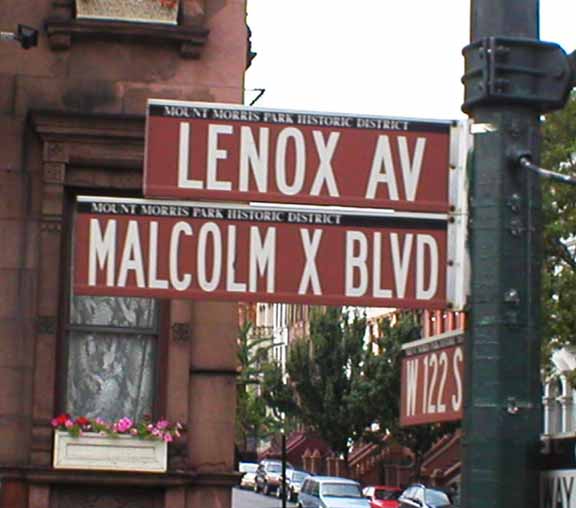 |
| Harlem: a perfect place to lift up the downtrodden. |
|---|
I have a bachelor’s degree in sociology. Looking back, all my professors were white and very liberal. College was the first place I ever heard race discussed seriously, and the message was constant: diversity was vitally important and whites were guilty. My fellow students had been brought up just as I had been, so my professors had very fresh meat to feast on. I graduated from college the perfect racial liberal.
Like so many white, middle-class girls from the New York City suburbs, I therefore decided to serve the downtrodden. I knew I could never live well on my salary, but the satisfaction and moral superiority I would enjoy over friends in business would be worth the sacrifice. I would venture into the ghettos, much like an urban Jane Goodall, and protect noble souls from the evils of white privilege and arrogance. I genuinely believed I would be making amends for the terrible acts of my ancestors.
The first job I took as an adult was in the daycare center of a domestic violence shelter on Staten Island, New York. It was part of a network of organizations run by a large charity called Safe Horizon.
| I have seen whites go on their knees before blacks and apologize for slavery, white privilege, blacks in prison, etc. |
|---|
This was my first real encounter with blacks and Hispanics. My supervisors were black and Hispanic, the clients were black and Hispanic (I never saw a white woman come in), and I was one of the only white faces in the neighborhood. I felt as though I had to prove to these women and teach their children that white people were not their enemy. I thought that if I could make them see me as a good person and not as a “white person” I could help make the world a better place. I was convinced I had nothing to fear, and that my generosity would certainly be noticed and appreciated.
The women who came in did not have to prove abuse; they just had to show a police report. Later, in conversations with the mothers, I learned that much of the abuse was phony. All they had to do was walk into a precinct and say they had been assaulted. Before I took the job, I could not have imagined that anyone would lie about being abused.
The women could stay rent-free for three months, and then their cases were reevaluated for extension. All they had to do then was seem scared or present some marginally coherent story to get extensions. In some cases, women finagled the system and managed to stay in the shelter for nearly two years. Most got apartments to themselves, though some had private bedrooms but shared a kitchen and living room.
At the daycare center, my job was to take care of the children while the mothers were getting their lives back together. I also helped children get into schools in the neighborhood, as they now lived in a completely new area, and were not supposed to tell anyone where they were for fear the abuser would track them down.
I devoted myself to the children, some of whom, like their mothers, had suffered serious violence. I assumed that these women, who didn’t work, didn’t go to school, and didn’t seem to do much but have lots of children, would be experts in child rearing. Hispanics, especially, who all seem to have large broods and for whom procreation seems to be the center of their lives, would teach Americans new techniques in child care that would be a great lesson for our society.
 |
| Caring for the children of others. |
|---|
I was horrified to find that black and Hispanic mothers alike routinely left their children in unchanged diapers until they were covered with feces. They would take children — often younger than 10 — to R-rated, midnight horror movies. They would let children play on busy streets without the slightest concern for their safety. They littered their quarters with pizza boxes, soda cans, filthy clothes, and upturned furniture.
I was shocked but not discouraged. I began spending extra hours after my shift ended, taking care of the children as if they were my own. I would wash their diarrhea-sodden bodies and clean their filthy apartments. I would rock crying, fever-stricken children to sleep while the mothers were out buying malt liquor and cigarettes with their WIC money (Women, Infants, and Children — a food-payments program for poor women with children up to age five), getting ready for a date with whatever ghetto gigolo they were courting that week. I would throw birthday parties for the children and attend school functions because their mothers could not be bothered. This devotion earned me no respect or appreciation. The mothers called me “cracka ass” and “white bitch” while I labored on their behalf.
I did notice racial differences. On the whole, the Hispanics were cleaner and quieter than the blacks. Their standards were below those of the average white, but higher than the average black. Many despised the blacks with whom they were forced into contact. Hispanic mothers were there mostly for free services, and were always looking for the next entitlement. They were intensely proud of their ethnicity, and would explode into anti-white, anti-American anger if they felt slighted in any way — this included being denied a service or being asked to pay for something they thought should be free. They were often inarticulate to the point of being unintelligible, but it was clear that they thought America owed them anything they needed.
Even the more reasonable, friendly clients and staff constantly explained their failures by saying, “The white man keeps me down.” I learned that many blacks and Hispanics sincerely believe this cliché, no matter what their salary or station in life.
I never complained, and did everything with zeal and professionalism. I was nevertheless passed over for promotions and received scant appreciation from clients or staff. In that community, socializing seemed to be the key to popularity and promotions, and hard work seemed to be greeted with disdain. If I designed a new program for the staff, they resented it because it meant they would have to work, which was something they did only when forced.
I got complaints from clients. Some said I was arrogant and behaved as if I thought I was superior to them: “She thinks she betta than us cause she be in college!” The director — a black woman — told me I shouldn’t flaunt my privileged background. Wearing a T-shirt with my college name on it, for example, was considered offensive.
I also got in trouble for expecting people to follow the rules for using the daycare center. All children were welcome from 3:00 to 5:00 p.m. for help with homework (management had the good sense to realize that our clients could not or would not do that). Otherwise, they were supposed to look after their own children unless they gave us advance notice and showed proof of an appointment or some other obligation. In fact, the mothers were always trying to “dump” children into daycare so that they could go out with boyfriends. This was a common fraud, but I tried to stick to the guidelines.
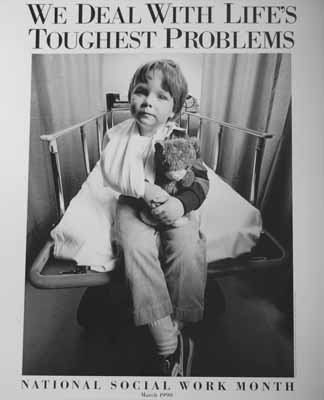 |
| Not quite the way it turned out. |
|---|
Once, after I denied a woman’s last-minute request to take her children, she complained to the director. I was called into the director’s office, where the woman said, “You do not want to take care of my children because you think you are better than us.” Of course, the director took her side, scolded me in front of her, and countermanded my decision. The mother’s fraud worked, and I had to watch her children that day.
I thought our program should teach the women to be better mothers to their children, and not to put them into daycare at every opportunity. After the director disciplined me for following the guidelines and trying to prevent fraud, she accused me of racism and told me, “We are here for the mothers, not the children.”
I went home crying that day, shocked for two reasons. I could not understand how anyone could possibly think I was racist, and I believed that whatever the shelter was for, the needs of the children came first. After almost two years at the shelter, I decided to find a different job, and switched to an administrative office in Manhattan.
Later I got a job at a different charity run by Safe Horizon called “The Streetwork Project.” This was a “drop-in” center in Harlem for “street involved youth” up to age 24. The majority of the clients were local teenagers, most of whom did not work, and who had drug habits that kept them in a state of desperation. They tended to be gang members, prostitutes, and runaways. Streetwork offers shelter, counseling, food, showers, a music room, computer labs, basic medical attention, and even acupuncture and meditation. It also served as an unofficial safe haven for illegal aliens and other criminals hiding from the police.
Safe Horizon and all of its programs are funded by city, state, federal, and private funds. One of my jobs at Streetwork was Coordinator of Data Quality and Reporting, which entailed keeping statistics. Almost every month my supervisor changed my report, increasing the number of clients served, so we would get more funds from backers.
When I interviewed at Streetwork, the supervisor’s very appearance should have been a warning, but years of indoctrination had conditioned me to squelch sensible worries. The man was large, black, dreadlocked, and obviously homosexual. A huge wooden penis sculpture was prominently displayed on his desk. He ended the interview by telling me, “Especially because you are a pretty white girl, you are not going to fit in here at Streetwork until you sleep with somebody here.” I laughed because I thought it was some sort of joke.
The Streetwork motto is “We are a non-judgmental environment.” Yet, every Wednesday all 75 staff members were required to meet in a circle and air their grievances. For eight to ten hours every Wednesday, these mandatory sessions would interrupt our mission to serve children in trouble and force us to play out our personal lives to a crowd of co-workers. More times than not, a black staffer — they were the vast majority — would vent his anger against a white staff member for no apparent reason. It seemed that it was an offense if white people were not sufficiently subservient or reverential to blacks.
| Gender non-specifics are people who decide each day which sex they want to be, and they insist on being referred to as gender-neutral “ze” instead of he or she. |
|---|
The unintentionally offending white person would be made to grovel at the feet — yes, I have seen whites go on their knees before blacks — and apologize for slavery, white privilege, blacks in prison, the poor state of black neighborhoods, AIDS, drugs in their community, etc. Often the white worker was reduced to tears in a desperate attempt to appease the mass of angry black and brown faces. Finally, when the white employee was humiliated enough, and the cathartic cleansing had been achieved, a tentative truce would be called. The angry black employee would be praised and his anger encouraged, while the traumatized, cowering white worker would be put on probation and, through an act of supreme magnanimity, allowed to keep his job. These sessions were supposed to be run by social workers, but often just ran themselves while the social workers watched.
I was required to attend these sessions, and sometimes the spotlight was turned on me. I was never fully and publicly brutalized, but the anti-white sentiment was clearly directed at me as well.
Racial politics were very strict. We were forbidden to observe Columbus Day because Columbus was a “genocidal racist.” Instead, I had to observe Martin Luther King Day and black history month. In fact, I was required to do unpaid, after-hours work on King day.
I saw the only white, heterosexual male employee fired for saying “black people are born to dance,” in a moment of self-deprecation at a bar after work with co-workers. Apparently, a white man didn’t have the right to say anything about race, even if it was flattering. This white man was framed for a robbery and fired. Everyone on the staff knew he was innocent of the robbery, but he was white and proved himself to be a racist by that remark, and to them, that was reason enough to fire him.
Sometimes we were forced to participate in diversity or sensitivity training, and often we were split into groups by sexual orientation. There were heterosexual, homosexual, bi-sexual, transgendered, and gender-non-specific groups. Gender-non-specifics are people who decide each day which sex they want to be, and they insist on being referred to as gender-neutral “ze” rather than he or she. On Monday, such a person is Brenda, but next month, Brenda may become Carlos. Then a week later, Carlos becomes Brenda again, and if you mistakenly call her Carlos, you are in danger of being fired for discrimination or at least sent to special “sensitivity classes.” We had about eight of these “ze” people, and it was an even split between biological men and women.
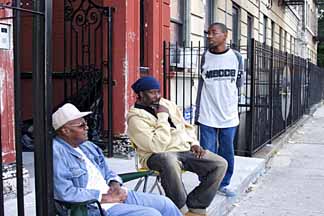 |
| Loitering black men screamed filthy comments. |
|---|
The view of the staff was that the country was overrun with white, Jesus-freak-bigot, heterosexual “breeders,” and that anything that undermined that order deserved support. The heterosexual, white world was bland, unintelligent, uncreative, unattractive, morally repugnant, and something that needed to be eliminated. Therefore there was intense pressure, which included psychological prodding, to try to convert a heterosexual into something else. When a middle-aged white, married woman with teenage children walked out of the heterosexual group to count herself amongst the bisexuals, there was tremendous applause and a daylong celebration in her honor.
We gave away free condoms and held safe-sex workshops, AIDS clinics, and offered counseling to child sex victims and prostitutes. Yet, the staff used donor money to take the children on a field trip to the New York City Museum of Sex, which glorifies every conceivable type of promiscuity and degeneracy.
There was a heavy sexual atmosphere at work. I was always being sent X-rated email, and people would stop by my desk and make filthy comments about my body. After one foul remark, one man even said to me, “That would be sexual harassment anywhere else, but this is Streetwork.” Homosexuals would describe the previous night’s sexual exploits in graphic detail. Men were always exposing themselves to women on the job, and nobody complained or reported it.
Streetwork had a no-violence policy, but we helped hide violent criminals. Even when staff knew that a client had raped, robbed, or even tried to kill someone, they hid weapons, gave false alibis, and obstructed police investigations. They would not let the “white devil” get his hands on another “beautiful black child.”
During the 2008 elections, Streetwork did everything possible to get “street involved” young people to register and vote for Barack Obama, including bribing them with free metro cards, McDonald’s food vouchers, and other gifts donated to the organization. It is against the law for a nonprofit organization to try to influence elections.
All standards of decorum and professionalism were considered “white.” Instead, the management at Streetwork considered partying (with drugs and alcohol) and sex among staff members essential to the workplace. Staff members who did not take part in these debaucheries were isolated and eventually brought before David Nish, a homosexual who was vice president and top day-to-day manager of Streetwork. He would accuse them of “not being a team player,” and they were either fired or forced out by some other means.
At Streetwork, every aspect of race was turned upside down. The day after six people were shot in front of our building, I said that Harlem was a dangerous place. For this I was reprimanded and told to “shut up,” because that reflected an ignorant view of Harlem and of blacks. When I bought a house in Staten Island, I was brought before Mr. Nish to explain myself. Streetwork considered Staten Island a racist place because it is 75 percent white. The staff also said it was “dangerous” because people of color could not walk down the streets without being attacked.
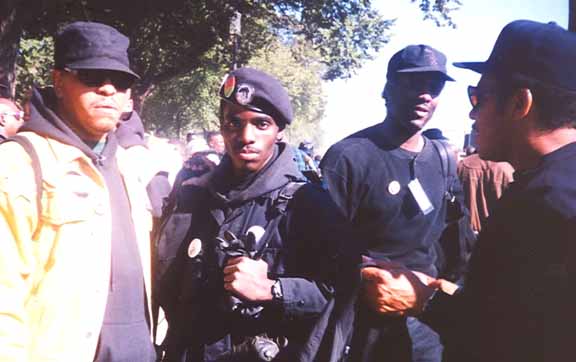 |
| A visit from the Panthers always stirred up the black children. |
|---|
It was, of course, the reverse that was true. On the streets of Harlem, my blonde hair, blue eyes, and white skin made me an irresistible target. I was cursed at, intimidated, and had beer bottles thrown at me from moving cars and high windows. Once, when I stopped and bent down to tie my shoe laces, somebody dropped a ten-pound barbell from an apartment building, which smashed the pavement just inches away from me. I was once surrounded by a group of black girls who promised to kill the “snowflake” who was in their neighborhood. I could not walk ten feet without hearing grotesque and threatening sexual comments screamed at me from loitering black men who followed me from the subway to the front door of the Streetwork building.
Our office regularly got phone calls from angry blacks who said they were going to “get that white bitch.” When I answered the phone, even some of the clients would say, “Are you that white bitch? I’m going to get you!!” You often see the slogan “Keep Harlem Black” in windows, store fronts, and on cars. I assume that the purpose of the calls was to drive me out.
Of course, when I brought this to the attention of management I was told either to “shut that mouth!” or that I was learning a valuable lesson in what blacks and Hispanics go through in white areas. Most times, my grievances to management or appeals for help ended with my being the target of another group sensitivity experiment, in which I was belittled and called a bigot for succumbing to my innate white, racist tendencies. On another occasion, I was called into the office of the senior director — a black man in his 50s — who told me to read a book about “white privilege,” because I lived in a bubble and that bubble had to be burst.
The Streetwork project used donor funds to invite the New Black Panther Party to speak to our young clients. I had to appear excited at the prospect, although it always made me feel unsafe, because the Panthers stirred up the children to the point they would attack or at the very least &ldldquo;dis(respect)” any non-blacks in their paths. Streetwork thought this was good for the clients, because it gave them pride, and inspired them to fight against the white man instead of each other.
Why?
Why, you are wondering, would a white person work in a place like this? That is a difficult question to answer. For myself, I went into this field, because I was trying to make a difference. I wanted to help people who were suffering, and I thought I was doing the right thing.
I think some whites find the ghetto environment exciting, and consider the racial abuse to be just another interesting facet of their adventurous new life. Popular culture certainly plays a part in pushing people in this direction. Some suburban whites idolize blacks and see their ghetto world as a playground for the imagination. Popular music, movies, sports, and television are largely black oriented, and white children come to believe that white is lame. In fact, I can remember white friends, during my teenage years and even to this day, criticizing something by saying, “That’s so white.” People from the suburbs may think they are missing something, and that they can live tragically hip lives among ghetto blacks.
Whites in these situations accept astonishing abuse, yet they are proud of their work and think they are improving the world. It seems that “white privilege” is an extremely powerful concept that makes some people believe they deserve humiliation. It leads to a bizarre form of cultural suicide, and an inability to defend one’s own interests.
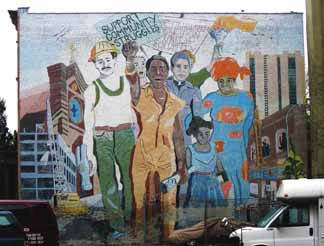 |
| A wall in Harlem. |
|---|
One of the people who was publicly humiliated at one of the Wednesday sessions was an attractive white woman who was engaged to an actor. Even after being attacked and scorned for weeks, she kept coming to work. She probably didn’t need a full-time job, but she loved being there. She loved being leered at by Harlem blacks, and was sleeping with several of her black and Hispanic coworkers. Clearly, this was kept a secret from her handsome, white, soap-opera-actor boyfriend, whom many women would have thought an enviable catch.
I should add that Streetwork was something like a cult, and tried to control every aspect of our lives. The managers set the tone and encouraged us to believe that we were immensely fortunate to have such a wonderful job in which we were loved by our clients, co-workers, and supervisors. We scorned outsiders, and believed that being “inside” was the most important thing in the world. Streetwork considered itself a self-contained, multicultural and multi-sexual paradise and model for the world. We were constantly indoctrinated and pushed to live by the narrow Streetwork dogma.
The staff were very intertwined in each other’s personal lives. We went to happy hour after work together every day, and every weekend we attended parties and various events together — always together. We gave each other advice on intimate aspects of each others’ lives, but always filtrated through the liberal, diversity, multicultural prism. For example, when I bought the house in Staten Island, I was told I should stay in a lousy apartment in a bad neighborhood, so that I could better understand the plight of the black man. I was dating a musician, who sometimes went away on tour. My “friends” told me to cheat on him as much as possible, so I wouldn’t care if he were doing it himself.
In fact, it was my boyfriend, an outsider to this world, who began to change my thinking. He is an intelligent, white, eighth grade drop-out who has traveled the world as a piano player since he was 18. He was never subjected to the multiple layers of indoctrination that the typical white, suburban person gets in high school, college, and the workforce. He even owned a copy of Jared Taylor’s Paved With Good Intentions. It took someone like him, far outside of the conventional system, to explain to me how crazy Streetwork was.
He knew that everyone at work referred to him as “that white boy you are with,” so he wrote a letter to a black staffer — one of the worst offenders — and addressed it to “Black Boy.” The purpose was not to offend, but simply to point out the hypocrisy and double standards of claiming to be “non-judgmental” while constantly slurring whites, but considering “black boy” a deep insult. My boyfriend also helped me realize that no one was ever better off at Streetwork, despite my efforts. All I saw was abuse of the system and lack of gratitude.
My attitude at work began to change. I started objecting to sexual harassment. I stopped letting Streetwork examine and analyze my personal life. This alone made me a social outcast, but the fact that I was dating a “white boy” from the suburbs was cause for great alarm. People who I thought were my friends treated me as a pariah because I was not keeping to the Streetwork policy of spurning the white man. My ideas were ignored, and incompetents were promoted to positions once promised to me. The large black man who first interviewed me called me into his office to tell me how worried and disappointed he was. He promised me a very substantial promotion if I “came back to the fold” rather than return to my “bubble.”
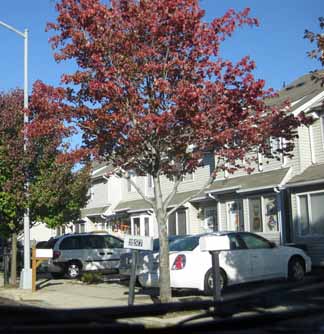 |
| Staten Island: obviously dangerous for blacks. |
|---|
I handed in my resignation anyway. Vice president David Nish telephoned me and begged me to come back in for a discussion. He told me how much he cared about me and that my happiness and success were his main concern. My boyfriend agreed that I should go see him because we thought I might be offered the long-promised promotion. On the drive out to Harlem, we put together a list of offenses and abuses I had suffered. I thought that if Mr. Nish really cared about me he would correct the abuses.
When I arrived I was shocked to be greeted by an entire “intervention group.” The first thing it did was to send me back outside and tell my boyfriend, who was waiting for me, to go home. When I came back in, they all had copies of the “Black Boy” letter my boyfriend had sent. Just as he had said they would, they used the letter to label him a dangerous bigot. I was shocked to see this roomful of people, including the vice president, brandishing this personal correspondence.
Next, they lied, and claimed that my boyfriend had written letter after letter to various people within the organization. In a clear attempt to make me feel guilty, they said he was angering people throughout the organization and was getting in the way of the “the mission.”
I presented my list of abuses but they dismissed every one, saying that “this is what goes on at every job site.”
Next, David Nish explained that he had 30 years of experience observing domestic violence, and he could see blatant warning signs. He asked if my boyfriend ever hit me or got angry. I said he never hit me but was angry at how I was treated at Streetwork. “Well, that is the first step of abuse,” he said. “I’m sure that if he hasn’t started hitting you yet, he will start very soon.”
While the rest of the group looked on, gesturing their approval, he talked for an hour or more: You are in grave danger. We love you and you’ve been with us for so long. This guy you are seeing has only been around for a few months. You can’t know everything about him, but we know the warning signs. This is what we do for a living. We see the changes in you. Haven’t you noticed your coworkers have not been talking to you? That is because they miss the old Tracy, whom this new boyfriend is trying to kill. Are you going to let him kill you?
They made my boyfriend seem like he was a psychotic, dangerous bigot from whom I needed to escape. His opinions were unlike those of anyone else in my life, and he was the minority. Faced with this vast sea of important people who claimed to be on my side and against him, I felt powerless to resist, and foolish to disagree. They made me believe I was in great danger.
I look back in horror and amazement at this, but after this brainwashing I actually agreed to call my boyfriend, break up with him, and order him out of the house we were sharing. Several people listened in on the call, taking notes, and planning the next steps to make sure the breakup was permanent. Mr. Nish then sent me right back to work at my old job.
 |
While I worked, shivering from what I had been through, Mr. Nish made arrangements for me to go into a domestic violence shelter. He called my parents and friends to tell them how he had rescued me from my wicked boyfriend. He then called me back into his office and offered to call the police and send them to my home to make sure my boyfriend was out. He even ominously offered to send “some other people, not cops” to throw him out. I said that would not be necessary.
After my unexpected full day of work, I got into a taxi and was on my way to a “safe house” when the cruel absurdity of it all began to hit me. The further I rode, the clearer it became. I told the driver to change routes and take me home to Staten Island and my boyfriend. He had been bewildered by my phone call but was waiting for me, determined to speak face to face. That night, I left a message for Mr. Nish and told him I would not go back. I never did. The next morning he called me at home, but I didn’t answer the phone and he left no message.
After that, I was completely cut off from everyone associated with Streetwork. No doubt the word went out that I was to be shunned. All the people who claimed to care about me, all the people who called themselves my friend for life disappeared.
At first I couldn’t understand why the vice president of an important, non-profit organization like Safe Horizon as well as other executives would go to such bizarre lengths to keep me in their control. I would imagine it was partly because they could not stand to think that someone might not like the perfect, liberal paradise they think they have built for themselves. It deflates their sense of superiority for someone to see through them.
Later, I learned from someone who worked in personnel at Safe Horizon that Streetwork was in a crisis for several months after I left because no one knew how to do my job or even the jobs of others I had been doing for them. It seems that a madhouse of homosexuals, transgendereds, gender-non-specifics, unqualified blacks, anti-American Hispanics with poor language skills, and unrepentant gang members, all organized according to principles of diversity and multiculturalism, did not run properly without a white slave doing the work. I learned that I was doing the jobs of more than ten people who spent their days socializing, shirking work, and pilfering from the donation room.
I once believed that my experiences involving race were unique to the places where I worked. I have since heard tales similar to mine, if not so harrowing. All the whites involved meekly accepted what happened to them as part of the march of progress toward a new world and a new way.
 |
| Safe Horizon public service: white abuser and white victim. |
|---|
My father, for example, after 20 years with the New York City Transit Authority, was forced into retirement when a black man was elevated to one of the highest positions in the authority. My father once heard him say to a meeting of chiefs, “There’s too much salt in here — now I’m gonna add some pepper.” Personnel policies changed drastically in favor of blacks. It became difficult for whites to get promotions, and the workplace became intolerable for my father.
My sister works for a large medical insurance company used by most of the people who work for New York City. She is one of the secretaries to the black CEO. She is the only white person in the office, and she is kept there to do all the work the others won’t do. Her black coworkers show up two hours late, take an extra hour for lunch, and leave one or two hours early, nearly every day. Last winter, she was scolded by her boss for coming in 30 minutes late on a day when a snowstorm hit and nobody else in the office came in to work at all. Recently, a black co-worker disappeared for two weeks. When she came back, she told the boss her baby had been dying in the hospital. Later that day, it became clear that she made the story up; she just wanted a vacation. This black woman got a salary increase and was promoted over my sister’s head.
Although I have left Safe Horizon and Streetwork for good, I still see some of the things I noticed there at my current job in an emergency room, where I help doctors treat patients. The doctors spend an enormous amount of time looking after indigent, uninsured Hispanic children who have nothing more serious than skinned knees, headaches, or diarrhea. The doctors are furious at having to prescribe aspirin and Band-Aids to clueless Mexicans, and even have a saying for it: “Hispanics come dancing into the ER and whites come in on their backs.”
Everyone who works around blacks and Hispanics knows the truth about them. Many who don’t, know anyway. But the propaganda mill is always working to show things as they are not. Not long after I left my job at Streetwork, Safe Horizon produced a public service TV clip about domestic violence (you can find it on YouTube if you look for “safehorizon trailer”). The abused woman looks superficially similar to me and her abuser is a white man who looks something like my boyfriend. Perhaps it was a coincidence, perhaps not. The poor white girl goes to her non-white co-workers for help and protection.
While I was at Safe Horizon, I compiled the statistics for the shelter’s clients. Approximately 92 percent of the violence was committed by black men, 7 percent Hispanics, and less than 1 percent by white men. Somehow, Safe Horizon chose to depict an evil white man, a helpless white woman, and noble non-whites who rescue her.![]()


